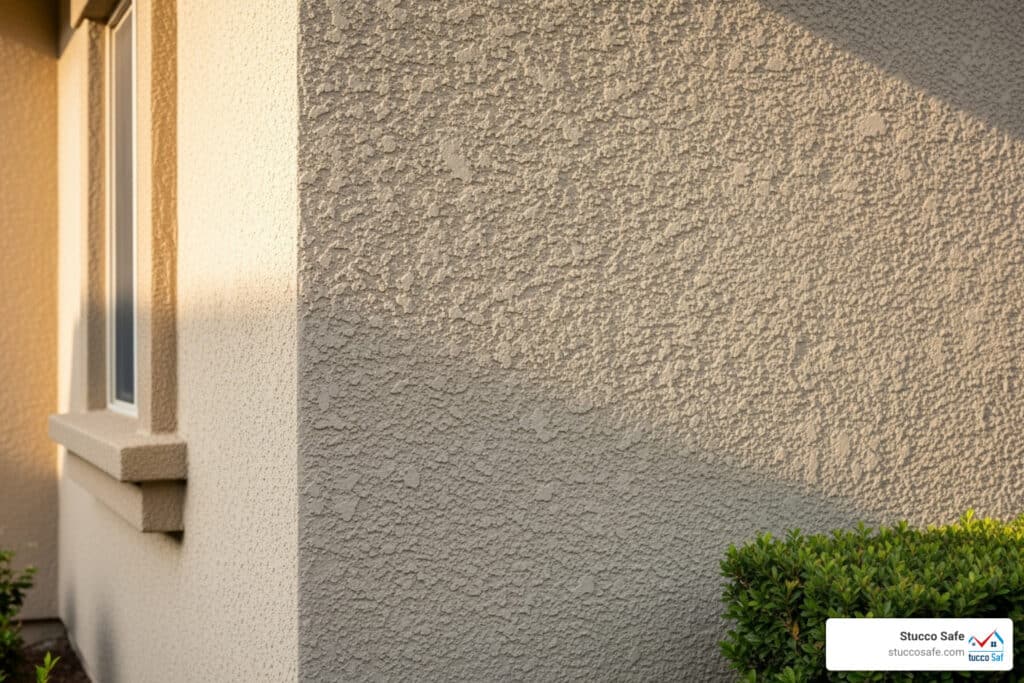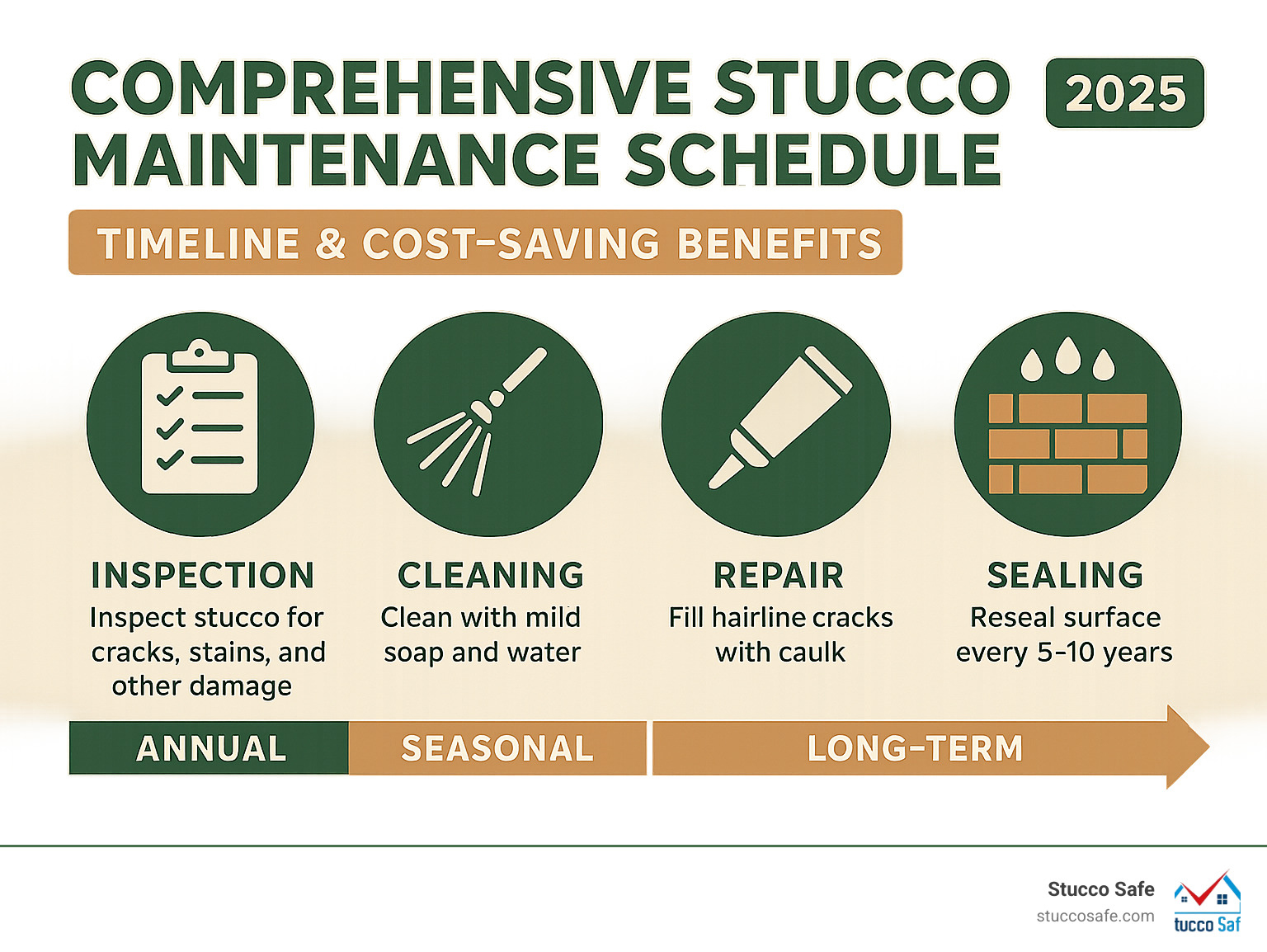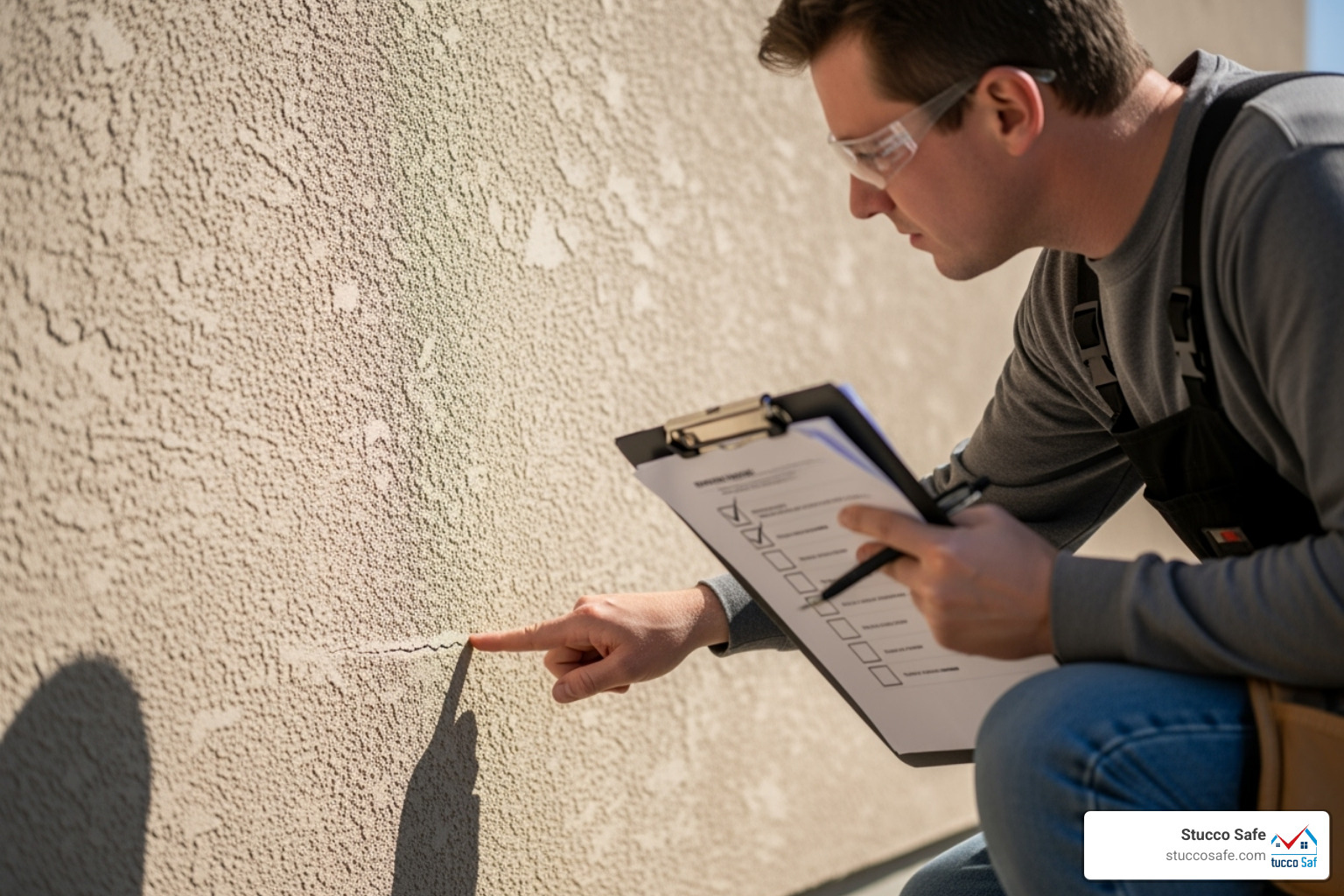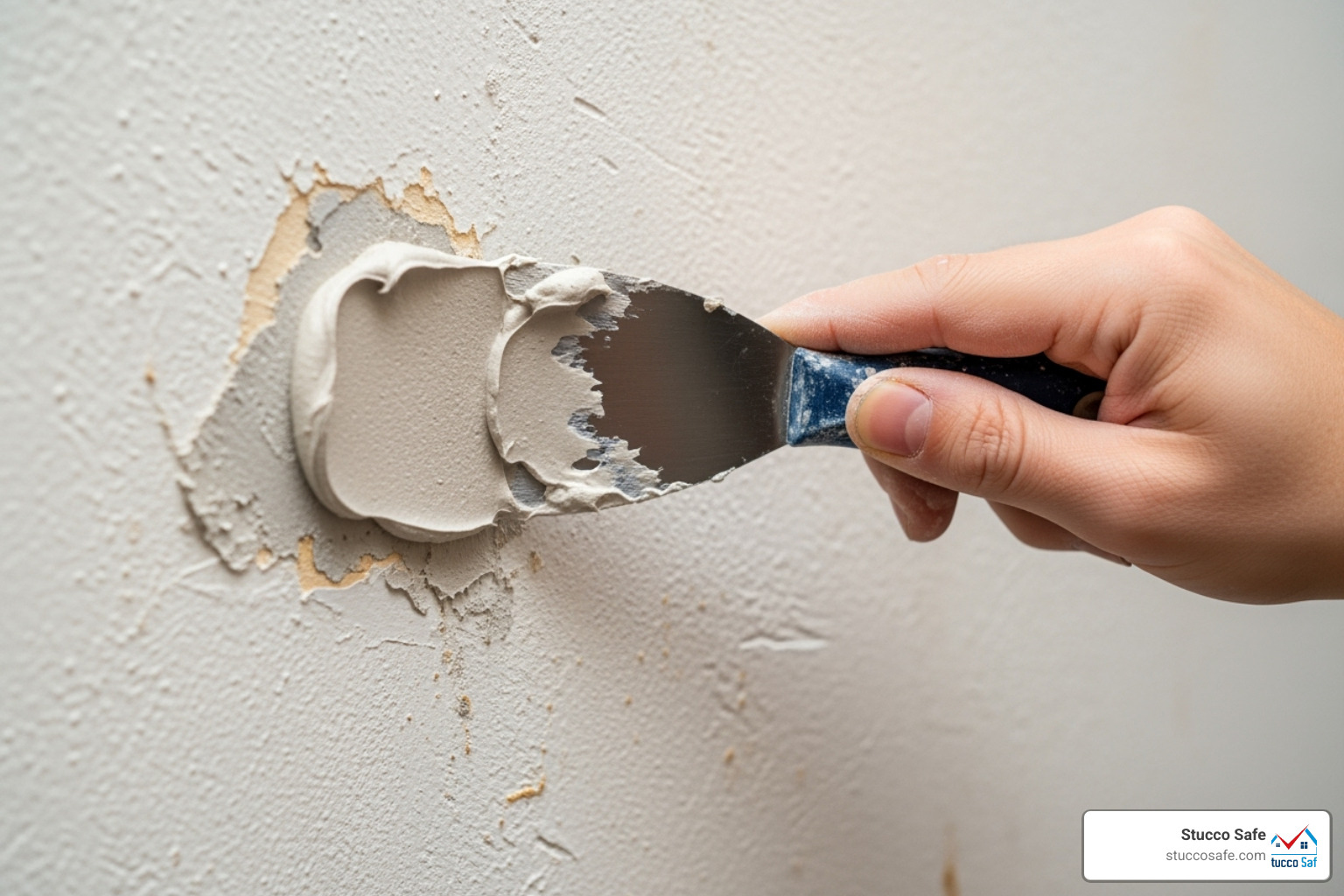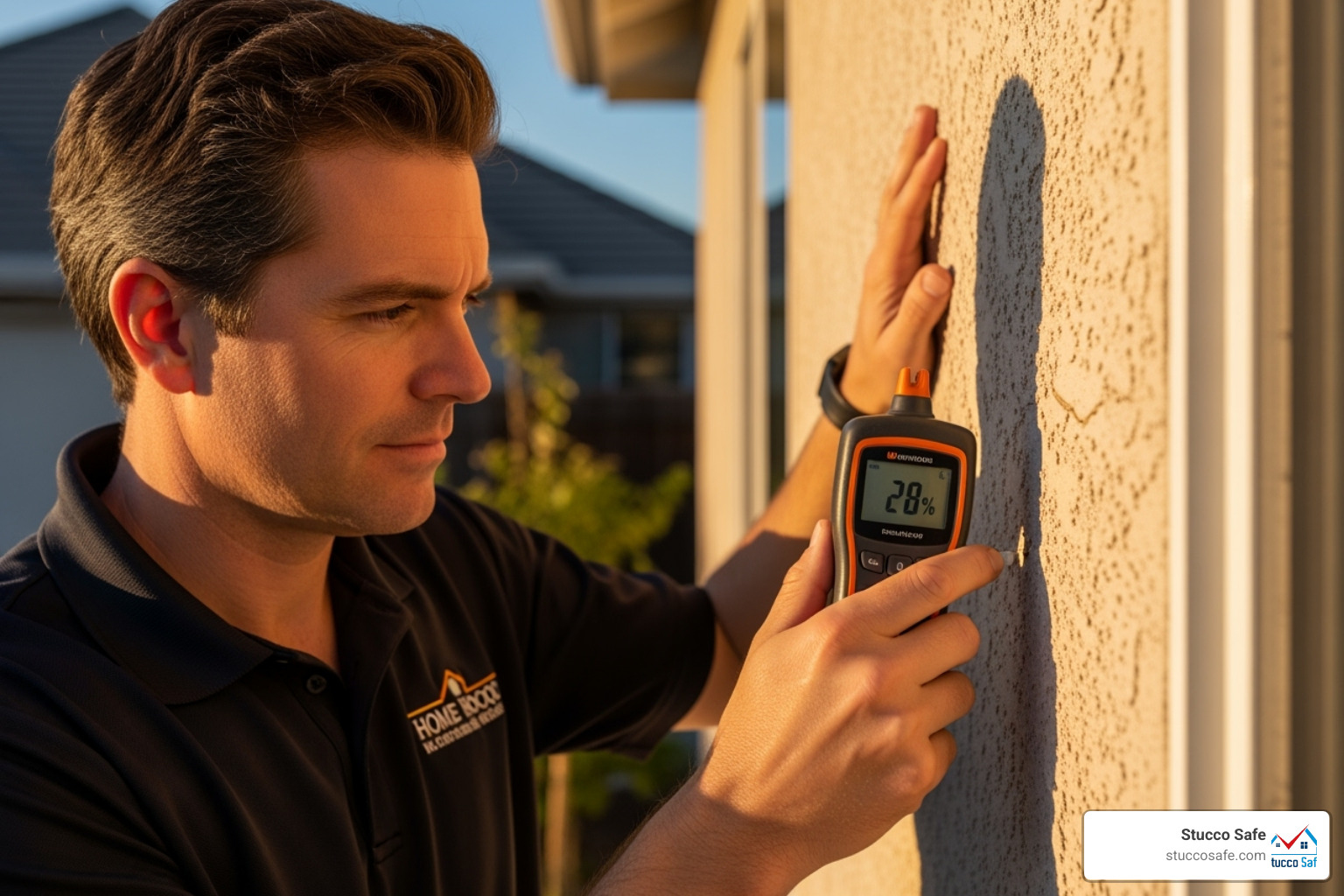Stucco wall maintenance: 3 Simple Steps 2025
Why Your Stucco Exterior Needs Regular Care
Stucco wall maintenance is essential for protecting your home’s exterior and preventing costly moisture damage that can compromise your property’s structural integrity and value.
Key Stucco Maintenance Tasks:
- Inspect your stucco annually for cracks, stains, and damage
- Clean exterior walls 2-3 times per year with mild soap and water
- Repair hairline cracks promptly with waterproof acrylic caulk
- Reseal the surface every 5-10 years with breathable sealant
- Monitor for signs of water intrusion like dark staining or soft spots
Stucco is a durable exterior finish made from Portland cement, sand, and water. When properly maintained, it can last 50 to 80 years while providing excellent weather resistance. However, neglecting routine care can lead to moisture infiltration behind the stucco, causing tens of thousands of dollars in structural damage.
The key to long-lasting stucco is understanding it’s a porous material requiring regular attention. Simple preventive steps like cleaning, sealing small cracks, and ensuring proper drainage can dramatically extend its lifespan.
I’m Gabe Kesslick, a specialist in leak detection and repair since 2001 with certifications in stucco inspection and building envelope forensics. My experience with thousands of stucco cases shows that proactive care prevents the expensive remediation projects that result from neglect.
Stucco wall maintenance glossary:
The Core Components of Stucco Wall Maintenance: Inspection, Cleaning, and Repair
Your stucco exterior is your home’s protective armor against the elements. Like any armor, it needs regular care to stay effective. Stucco wall maintenance involves three essential tasks: inspection, cleaning, and repair. Small issues caught early prevent the kind of water damage that can cost tens of thousands to fix.
Regular maintenance does more than improve curb appeal; it prevents moisture from getting behind the stucco, protects your property value, and helps your exterior reach its impressive 50-80 year lifespan. Much of this maintenance is straightforward work you can handle yourself. Let’s walk through each component.
The importance of regular maintenance
Step 1: How and When to Inspect Your Stucco
An annual stucco inspection is like a yearly physical for your home’s exterior. Plan a comprehensive walkthrough at least once a year, ideally in spring to assess winter damage. In areas with harsh weather, seasonal checks are even better.
For an effective inspection, use binoculars for hard-to-see upper areas, a notepad to jot down problem spots, and a moisture meter to reveal hidden issues.
Walk slowly around your home looking for cracks—both hairline and larger ones that might indicate settling. Pay special attention to grid-pattern cracks, as these often signal more serious problems.
Stains and discoloration tell important stories about your stucco’s health. Dark streaks from windows or roof lines usually mean water is getting where it shouldn’t. Green or black patches indicate mold or algae, while white powdery deposits (efflorescence) suggest moisture is pulling salts from the stucco.
Don’t just look—touch the surface. Gently press different areas, especially near windows, doors, and ground level. The surface should feel firm; any soft or spongy spots could indicate water damage or rot behind the stucco.
Check all gaps and openings around fixtures, trim, windows, and doors. Ensure caulking is intact and flexible, as these are common water entry points. Also, verify proper clearance from soil and landscaping for drainage.
While a visual inspection catches many issues, moisture problems can hide for years. That’s where professional expertise becomes invaluable.
Step 2: Safe and Effective Stucco Cleaning Methods
Regularly cleaning your stucco isn’t just about curb appeal—it’s preventive care. Stucco wall maintenance includes removing dirt, mold, and mildew before they degrade the surface. Plan to clean your stucco two to three times per year, adjusting for your local climate.
The safest approach uses a garden hose and soft bristle brush. Before you begin, repair any cracks to prevent water from seeping in during cleaning. Rinse from the bottom up to saturate the surface and prevent dirty water from staining dry areas. Once the stucco is wet, work from top to bottom with your cleaning solution and a long-handled soft-bristle brush. Work in manageable sections, scrubbing gently to lift dirt without damaging the texture.
Pressure washing can speed up the process but is risky if done incorrectly. Keep the pressure under 1,500 PSI, use a wide-angle nozzle, and maintain at least 12 to 24 inches of distance from the wall. Always spray at a 45-degree angle in smooth, sweeping motions.
Your choice of cleaning solution depends on the problem. Mild soap and water handles routine dirt. Always test any cleaning solution on a small, hidden area first. For mold, mildew, or algae, you might need a diluted bleach solution. Wear protective gear, ensure good ventilation, and rinse thoroughly. Avoid bleach on colored stucco as it can cause fading. Heavy-duty cleaning sometimes calls for TSP (Trisodium Phosphate), but it’s highly corrosive, so use full protective gear.
| Solution Type | Use Case | Application Method | Precautions |
|---|---|---|---|
| Mild Soap & Water | General dirt, light stains, routine cleaning | Mix a few drops of dish soap in a bucket of warm water. Apply with a soft brush. | Always test on an inconspicuous area first. Rinse thoroughly. |
| Diluted Bleach | Mold, mildew, algae (spot treatment) | Mix equal parts bleach and water (e.g., 1:1 ratio). Apply carefully to affected areas. | Wear rubber gloves and eye protection. Ensure good ventilation. Rinse very thoroughly. Avoid on colored stucco. |
| TSP (Trisodium Phosphate) | Heavy-duty cleaning, prepping for paint, deep stains | Dilute 15:1 water to TSP ratio. Follow product instructions carefully. | Highly corrosive. Wear rubber gloves, eye protection, and long sleeves. Ensure excellent ventilation. Test first. |
For extensive mold or mildew, professional cleaning services are often safer and more effective.
How mold and mildew thrive on moisture
Step 3: A Homeowner’s Guide to Stucco Repair
Catching and fixing small problems quickly is where stucco wall maintenance really pays off. A hairline crack that takes five minutes to repair today can prevent a major moisture problem costing thousands later.
Understanding the damage is key. Hairline cracks (less than 1/8 inch wide) are usually cosmetic issues from normal settling or temperature changes. While not structural concerns, they can still let water in over time. Larger cracks (wider than 1/8 inch), especially deep ones or those in grid patterns, signal more serious issues that might need professional attention. Crumbling stucco suggests the material is breaking down, possibly from moisture or installation problems.
For minor damage like hairline cracks and small holes, you can handle repairs yourself. Start by cleaning the damaged area thoroughly, removing any loose debris. The surface must be clean and dry before you begin.
Waterproof acrylic caulk is perfect for hairline cracks. Apply a thin bead into the crack and smooth it. For a more natural look, press fine sand into the wet caulk to match the texture. For small holes and gouges, use a pre-mixed stucco patch. Press the patch firmly into the damaged area with a putty knife, making it flush with the surface.
The trick to invisible repairs is matching the texture. Use a damp sponge or stiff brush to blend the new material with the existing pattern. Allow the repair to dry completely before painting—drying times vary from hours for rapid-set options to 28 days for traditional materials.
Protecting Your Stucco for the Long Haul
Think of your stucco as a marathon runner; with the right support and care, it can go the distance. Beyond cleaning and minor repairs, stucco wall maintenance includes strategic protective measures to create a fortress against weather.
The secret to long-lasting stucco is prevention. This means making smart decisions about sealing, painting, and managing water around your home. These proactive steps work together to keep your stucco performing flawlessly for decades.
How to Prevent Paint Fading on Stucco
Your stucco’s paint is a protective shield. When paint fades or peels, that shield weakens. With the right approach, you can keep that protection strong for years.
Proper preparation is absolutely critical. Before painting, your stucco must be completely clean of all dirt, grime, mold, and efflorescence to ensure a strong bond.
When choosing paint, acrylic latex paints are the gold standard for stucco. They are breathable, resist fading, and provide excellent coverage. For homes with older stucco or hairline cracks, elastomeric coatings are worth considering. These flexible, thick paints can bridge small cracks up to 1/8 inch wide, providing protection for up to 10 years.
Don’t skip the primer. A high-quality, breathable primer designed for stucco creates the perfect base, improving adhesion, coverage, and color retention.
A pro tip: your landscaping can help protect your paint. Strategic plantings that block harsh winds, debris, and intense sunlight can significantly extend your paint’s life.
A Proactive Approach to Stucco Wall Maintenance
The most successful stucco wall maintenance happens before you see problems. Think of it as preventive medicine for your home’s exterior.
Sealing your stucco every 5 to 10 years is like giving it a protective raincoat. A breathable sealant adds an extra layer of defense against water absorption and staining. The timing depends on your climate; wetter areas may need more frequent sealing.
Always clean and repair any damage before applying sealant.
Physical damage prevention is also key. Keep vegetation trimmed back from your walls—aim for at least 18 inches of clearance. Plants growing too close can scrape the stucco and trap moisture.
Window and door seals are critical. Check these seals seasonally for cracks or gaps. Remove old material and apply fresh, high-quality exterior caulk.
Perhaps the most crucial aspect is proper water management. Your gutters and downspouts should be clean and functional, carrying water at least five feet from your foundation. Ensure the ground slopes away from your home, and aim sprinklers away from the walls.
Does Stucco Exterior Require Maintenance?
Recognizing Serious Stucco Problems
Sometimes stucco wall maintenance goes beyond the routine cleaning and minor crack repairs we’ve discussed. When stucco problems run deeper, they can threaten your home’s structural integrity and cost you thousands of dollars if left untreated. The tricky part? Stucco often looks fine on the surface even when serious damage is happening behind the scenes.
Think of your stucco system like an iceberg – what you see on the surface is just a small part of the whole picture. By the time visible signs appear, significant hidden damage may have already occurred. That’s why recognizing these warning signs early is so crucial for protecting your investment.
Signs of Underlying Stucco Damage
Your stucco is constantly trying to tell you when something’s wrong. The key is learning to listen to what it’s saying. Here are the red flags that indicate problems beyond simple stucco wall maintenance:
Persistent stains and discoloration are often the first clues something’s amiss. Those dark streaks running down from windows, doors, or your roofline aren’t just cosmetic issues – they’re usually signs that water is finding its way behind your stucco and leaching back out. Once water gets behind the system, it can cause extensive damage to your home’s structure.
Efflorescence appears as white, chalky, crystalline deposits on your stucco surface. While it might look harmless, this powdery residue forms when water dissolves salts within the stucco or underlying masonry, then evaporates and leaves the minerals behind. It’s essentially your stucco’s way of waving a white flag, signaling clear water intrusion.
Bubbling or blistering stucco is another serious warning sign. When you see the surface starting to bubble up or blister, it often means moisture is trapped underneath, causing the stucco to separate from the layers beneath it. This delamination can quickly spread and compromise large sections of your exterior.
Soft spots are perhaps the most concerning sign you can find. When you press firmly on your stucco and it feels spongy, soft, or crumbly, it’s telling you that moisture has likely rotted the sheathing or framing beneath. This type of damage requires immediate professional attention.
Large cracks, bulging, or grid-pattern cracking goes far beyond the hairline cracks we discussed earlier. When you see interconnected cracks forming patterns, or sections that appear to bulge outward, you’re looking at potential structural movement, foundation issues, or severe moisture damage that’s compromised the stucco’s bond to your home.
Don’t forget to check inside your home too. Musty odors, water stains on interior walls or ceilings, damp drywall, or indoor mold spots can all indicate that water is penetrating your stucco exterior and affecting your home’s interior. These interior signs often appear before exterior damage becomes obvious.
DIY vs. Professional Help for Stucco Wall Maintenance
Knowing when to tackle a project yourself and when to call in the professionals can save you both money and heartache. We’ve seen too many well-intentioned DIY attempts turn minor issues into major headaches – and major expenses.
You can confidently handle routine maintenance tasks like regular cleaning with your garden hose and soft brush, sealing hairline cracks under 1/8 inch with appropriate caulking, conducting your annual visual inspections, and preventative measures like clearing gutters and trimming vegetation away from walls.
However, it’s time to pick up the phone and call a professional when you encounter anything more serious. Large cracks wider than 1/8 inch or areas where stucco is actively crumbling often indicate deeper structural issues that require specialized assessment and repair techniques. Any signs of water intrusion – persistent staining, efflorescence, bubbling, soft spots, or interior moisture – need professional diagnostic tools and expertise to identify the source and extent of damage.
Extensive mold growth requires professional remediation to ensure safe and complete removal. If moisture has damaged the sheathing or framing behind your stucco, or if your home was built between 1993 and 2006 (when building codes were less stringent and failure rates were higher), you may need complete stucco remediation or replacement – a complex process requiring specialized knowledge and equipment.
Professional stucco inspections provide peace of mind, especially when buying or selling a stucco home. At Stucco Safe, we use forensic testing methods with EDI (Exterior Design Institute) certified inspectors who provide completely unbiased reports since we don’t offer repair services. Our state-of-the-art moisture meters with hammer probes provide accurate readings from 1% to 100% moisture content, far more precise than cheaper alternatives.
Our comprehensive inspections include moisture and resistance testing along with detailed visual examination of your entire exterior facade. We serve throughout Southeastern Pennsylvania, New Jersey, and Delaware, with Stucco Inspections ranging from $495 to $1595 or more for very large homes, depending on size, location, and accessibility. This investment can save you tens of thousands of dollars by catching problems early.
Why Hire a Separate Stucco Inspector?
Frequently Asked Questions about Stucco Care
Over my years of inspecting stucco homes across Pennsylvania, New Jersey, and Delaware, I’ve noticed homeowners tend to ask the same questions. Let me share the answers to the most common concerns about stucco wall maintenance that come up during our inspections.
How often should you clean stucco walls?
Here’s what I tell most homeowners: clean your stucco two to three times a year. This might sound like a lot, but it’s really not when you break it down to just a few hours each season.
Think of it this way—your stucco is constantly battling the elements. Dirt, pollen, pollution, and organic growth like mold and mildew are working against your home’s exterior every day. Regular cleaning isn’t just about keeping things looking nice (though that’s a bonus). It’s about preventing these contaminants from breaking down the stucco’s protective qualities over time.
If your home sits near a busy road, under lots of trees, or in a particularly humid area, you might find that quarterly cleaning works better. I’ve seen homes where seasonal cleaning made the difference between a 20-year paint job and a 10-year one.
What is the best type of paint for a stucco exterior?
Not all paints are created equal when it comes to stucco. The key word here is “breathable”—your stucco needs to release moisture vapor, and the wrong paint can trap it inside, leading to the very problems we’re trying to prevent.
Acrylic latex paints are my top recommendation for most situations. They’re flexible enough to move with your home’s natural settling, they resist cracking and fading beautifully, and they allow moisture to escape while keeping water out. It’s like giving your stucco a raincoat that still lets it breathe.
For homes with existing hairline cracks or older stucco that’s seen better days, elastomeric paints are worth the extra investment. These thick, rubber-like coatings can actually bridge small cracks up to 1/8 inch wide and provide an additional waterproof barrier. I’ve seen elastomeric coatings protect hairline cracks for a full decade.
Whatever paint you choose, don’t skip the primer. A high-quality, breathable primer designed specifically for stucco creates the foundation for everything else. And remember—the best paint in the world won’t perform well on a dirty surface, so thorough cleaning and prep work is essential.
Are small, hairline cracks in stucco normal?
This is probably the question that causes the most anxiety among homeowners, and I understand why. Nobody wants to see cracks in their home’s exterior.
The short answer is yes, small hairline cracks are typically normal. I’m talking about cracks less than 1/8 inch wide that appear as single, isolated lines. These usually develop as your home naturally settles over time, or as the stucco expands and contracts with temperature changes. It’s just physics at work.
The good news is that these minor cracks rarely compromise your stucco’s water resistance, especially if your home has a proper weather-resistant barrier installed behind the stucco system. However, I always recommend sealing them with waterproof acrylic caulk as part of your regular stucco wall maintenance routine. It’s an easy prevention step that keeps small problems from becoming big ones.
What should concern you are larger cracks, multiple cracks forming grid patterns, or cracks that are actively crumbling. These can signal more serious issues like structural movement, foundation problems, or moisture damage that’s compromised the stucco’s bond to the wall. When I see these during an inspection, I recommend professional evaluation to determine the underlying cause.
The key is knowing the difference between normal settling cracks and warning signs of bigger problems. When in doubt, a professional stucco inspection can provide the peace of mind you’re looking for.
Conclusion: Protect Your Investment with Proactive Care
Your stucco exterior works hard to protect your home from the elements. In return, it needs care to provide decades of reliable service and beauty.
Stucco wall maintenance isn’t just about appearances; it’s about protecting your largest investment. A little attention now prevents huge repair bills later. Many homeowners face $30,000+ remediation projects that could have been avoided with regular care.
Most of what your stucco needs is straightforward: annual inspections, regular cleaning, quick repairs of minor cracks, and smart water management. These steps create a fortress against moisture damage.
However, peace of mind is invaluable. If you see warning signs like dark stains, soft spots, or persistent cracks, don’t ignore them. Our certified inspectors use forensic testing methods and professional-grade moisture meters to give you a complete picture of your stucco’s health.
Since we don’t perform repairs, our assessments are completely unbiased. We tell you what’s really going on with your stucco so you can make informed decisions.
Your stucco protects your home; return the favor with the proactive care it deserves.
Learn more about professional stucco services: Learn more about professional stucco services

